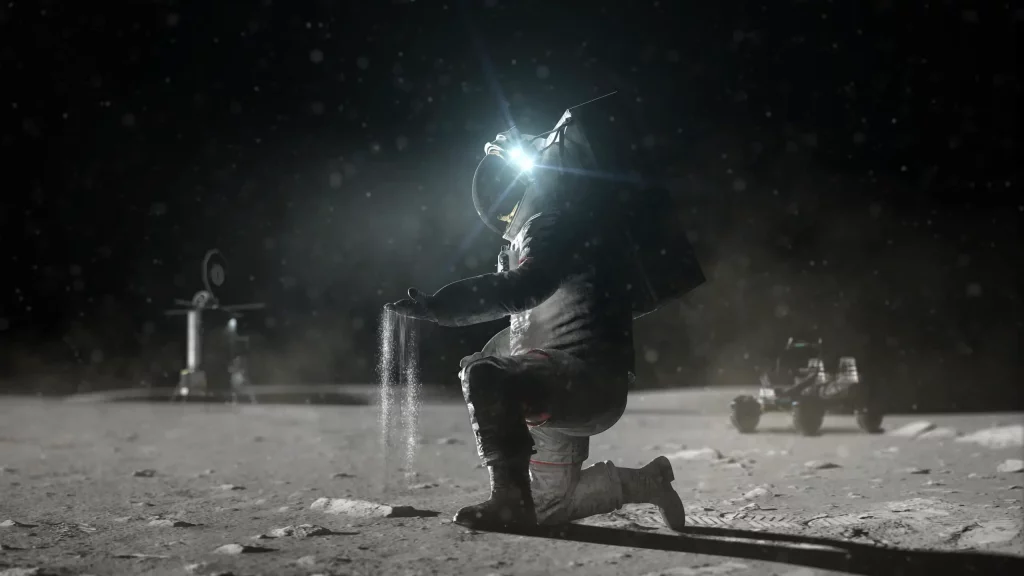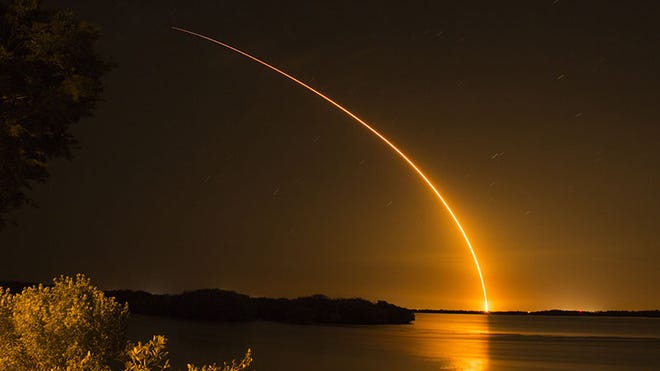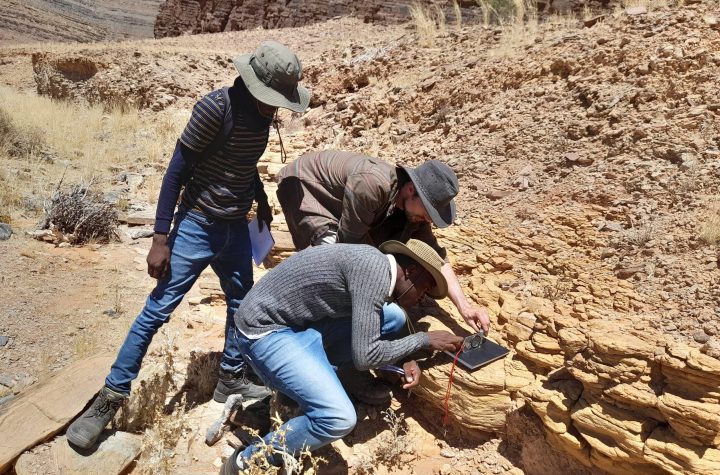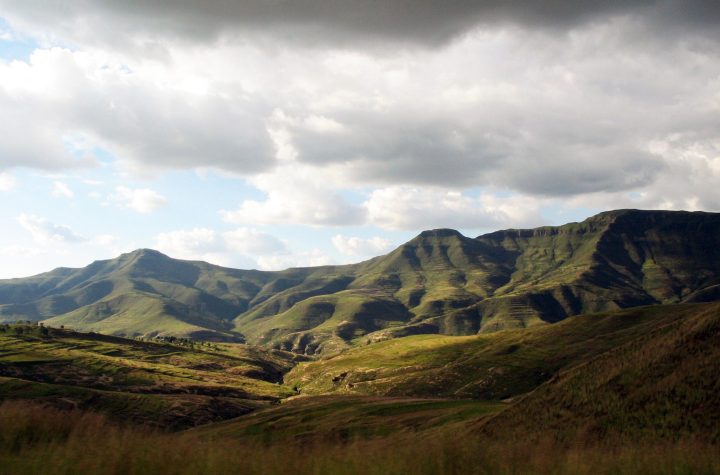Lanskap bulan yang berdebu, seperti yang divisualisasikan oleh NASA’s Advanced Concepts Laboratory. Kredit: NASA
Pada hari musim dingin, kehangatan matahari sangat disambut. Namun, saat umat manusia melepaskan lebih banyak gas rumah kaca, atmosfer bumi semakin banyak memerangkap energi matahari dan terus menghangatkan Bumi. Salah satu strategi untuk membalikkan tren ini adalah mencegat sebagian sinar matahari sebelum mencapai planet kita. Selama beberapa dekade, para ilmuwan telah mempertimbangkan untuk menggunakan layar, objek, atau partikel debu untuk memblokir cukup banyak radiasi matahari—antara 1 atau 2%—untuk mengurangi efek pemanasan global.
Sebuah studi yang dipimpin oleh University of Utah mengeksplorasi kemungkinan menggunakan debu untuk menangkal sinar matahari. Mereka menganalisis berbagai sifat partikel debu, jumlah debu, dan orbit yang paling cocok untuk membayangi Bumi. Para penulis menemukan bahwa menembakkan debu dari Bumi ke stasiun dalam perjalanan di “titik Lagrangian” Bumi-Matahari (L1) akan lebih efisien tetapi akan membutuhkan biaya dan upaya yang sangat besar. Alternatifnya adalah menggunakan moondust. Para penulis berpendapat bahwa pelepasan debu bulan dari Bulan bisa menjadi cara yang murah dan efektif untuk membayangi Bumi.

Pelepasan simulasi aliran debu antara Bumi dan Matahari. Awan debu ini muncul saat melintasi piringan matahari, dari Bumi. Aliran seperti ini, termasuk yang dilepaskan dari permukaan bulan, dapat berfungsi sebagai payung sementara bagi matahari. Kredit: Ben Bromley/Universitas Utah
Tim astronom menerapkan teknik yang digunakan untuk mempelajari pembentukan planet di sekitar bintang yang jauh, yang biasanya menjadi fokus penelitian mereka. Pembentukan planet adalah proses kacau yang melepaskan banyak debu kosmik yang dapat membentuk cincin di sekitar bintang induknya. Cincin-cincin ini mencegat cahaya dari bintang pusat dan memancarkannya kembali dengan cara yang dapat kita deteksi di Bumi. Salah satu cara untuk menemukan bintang pembentuk planet baru adalah dengan mencari cincin berdebu tersebut.
“Itulah benih dari ide tersebut,” kata Ben Bromley, profesor fisika dan astronomi dan penulis utama studi tersebut.

Simulasi debu yang dilepaskan dari waystation di titik Lagrange 1. Bayangan di tanah dibuat lebih jelas. Kredit: Ben Bromley
kata Scott Kenyon, rekan penulis studi dari Pusat Astrofisika | Harvard dan Smithsonian.
Makalah ini baru-baru ini diterbitkan di jurnal Iklim PLOS.
naungan cor
Efektivitas perisai secara keseluruhan bergantung pada kemampuannya mempertahankan orbit yang membayangi Bumi. Sameer Khan, seorang mahasiswa sarjana dan salah satu penulis studi tersebut, memimpin eksplorasi awal bahwa orbital dapat menjebak debu pada posisinya cukup lama untuk memberikan naungan yang memadai. Karya Khan mendemonstrasikan sulitnya menyimpan debu di tempat yang Anda inginkan.
“Karena kita mengetahui lokasi dan massa benda langit utama di tata surya kita, kita dapat dengan mudah menggunakan hukum gravitasi untuk melacak posisi simulasi pelindung matahari dari waktu ke waktu untuk beberapa orbit yang berbeda,” kata Khan.
Ada dua skenario yang menjanjikan. Pada skenario pertama, penulis menempatkan platform luar angkasa di titik Lagrange L1, yang merupakan titik terdekat antara Bumi dan Matahari di mana gaya gravitasi seimbang. Objek di titik Lagrangian cenderung tetap berada di jalur antara dua benda langit, itulah sebabnya[{” attribute=””>James Webb Space Telescope (JWST) is located at L2, a Lagrange point on the opposite side of the Earth.

A simulation of dust launched from the moon’s surface as seen from Earth. Credit: Ben Bromley
In computer simulations, the researchers shot test particles along the L1 orbit, including the position of Earth, the sun, the moon, and other solar system planets, and tracked where the particles scattered. The authors found that when launched precisely, the dust would follow a path between Earth and the sun, effectively creating shade, at least for a while. Unlike the 13,000-pound JWST, the dust was easily blown off course by the solar winds, radiation, and gravity within the solar system. Any L1 platform would need to create an endless supply of new dust batches to blast into orbit every few days after the initial spray dissipates.
“It was rather difficult to get the shield to stay at L1 long enough to cast a meaningful shadow. This shouldn’t come as a surprise, though, since L1 is an unstable equilibrium point. Even the slightest deviation in the sunshield’s orbit can cause it to rapidly drift out of place, so our simulations had to be extremely precise,” Khan said.
In the second scenario, the authors shot lunar dust from the surface of the moon towards the sun. They found that the inherent properties of lunar dust were just right to effectively work as a sun shield. The simulations tested how lunar dust scattered along various courses until they found excellent trajectories aimed toward L1 that served as an effective sun shield. These results are welcome news, because much less energy is needed to launch dust from the moon than from Earth. This is important because the amount of dust in a solar shield is large, comparable to the output of a big mining operation here on Earth. Furthermore, the discovery of the new sun-shielding trajectories means delivering the lunar dust to a separate platform at L1 may not be necessary.
Just a moonshot?
The authors stress that this study only explores the potential impact of this strategy, rather than evaluate whether these scenarios are logistically feasible.
“We aren’t experts in climate change, or the rocket science needed to move mass from one place to the other. We’re just exploring different kinds of dust on a variety of orbits to see how effective this approach might be. We do not want to miss a game changer for such a critical problem,” said Bromley.
One of the biggest logistical challenges—replenishing dust streams every few days—also has an advantage. Eventually, the sun’s radiation disperses the dust particles throughout the solar system; the sun shield is temporary and shield particles do not fall onto Earth. The authors assure that their approach would not create a permanently cold, uninhabitable planet, as in the science fiction story, “Snowpiercer.”
“Our strategy could be an option in addressing climate change,” said Bromley, “if what we need is more time.”
Reference: “Dust as a solar shield” by Benjamin C. Bromley, Sameer H. Khan and Scott J. Kenyon, 8 February 2023, PLOS Climate.
DOI: 10.1371/journal.pclm.0000133

“Kutu buku musik lepas. Pecandu internet bersertifikat. Pencinta perjalanan. Penyelenggara hardcore. “











More Stories
Makanan cepat saji dan daging olahan mungkin menjadi penyebab kanker di kalangan anak muda: dokter
Kapan peluncurannya? Bisakah saya melihatnya di New Smirna?
Sebuah studi baru memetakan awal mula kehidupan hewan